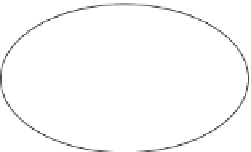Information Technology Reference
In-Depth Information
5.1. INTRODUCTION TO DIELECTROPHORESIS
Let us first begin with a discussion of the phenomenon of dielectrophoresis itself.
Following Pohl's seminal work on the subject [6], we first calculate the strength of
the dielectrophoretic force on a particle and then consider the consequences of
dielectrophoresis in media with different electromagnetic responses.
5.1.1. The Dielectrophoretic Effect
Dielectrophoresis is the net force experienced by a dielectric object in a nonuni-
form electric field. This effect exists because the dipole charges
q induced at
characteristic locations r
7
are subject to different values of the electric field E
e
(r),
as shown in Figure 5.1.
There is no net force in a homogeneous electric field, so we can expand,
7
*
e
ð
r
þ
Þ¼
*
e
ð
r
Þþð
*
*
Þ
*
e
ð
r
Þþ
O
ð
L
2
r
Þ:
For particles that are small relative to the characteristic length of a field gradient,
the net force is given by
*
¼
*
þ
*
þ
¼
q
ð
*
e
ð
*
þ
Þ
*
e
ð
*
ÞÞ ¼ ð
q
*
*
Þ
*
e
¼ð
*
r
*
Þ
*
e
:
r
Under vector transformation,
*
*
Þ
*
e
¼r
*
*
e
Þð
*
e
r
*
*
*
e
Þ
*
e
ðr
*
¼ð
*
ð
*
Þ
*
*
*
r
ðr
Þ:
*
e
¼
0, and for a dielectric that is isotropically, linearly, and homo-
geneously polarizable,
*
¼
v
*
Since
r
a
*
e
for body volume v and tensor polarizability
^
^
a
, the
force reduces to
1
2
v
2
*
*
ð
*
*
e
Þð
*
*
að
*
e
r
*
Þ
*
e
¼
* *
e
Þ
*
¼
v
¼r
r
^
^
ar
:
Notably, the above dielectrophoretic force is invariant under field inversion.
E
e
(
r
)
L
=
r
+
−
r
−
−
q
+
q
Figure
5.1.
Schematic of dielectric particle in inhomogeneous field.

















Search WWH ::

Custom Search